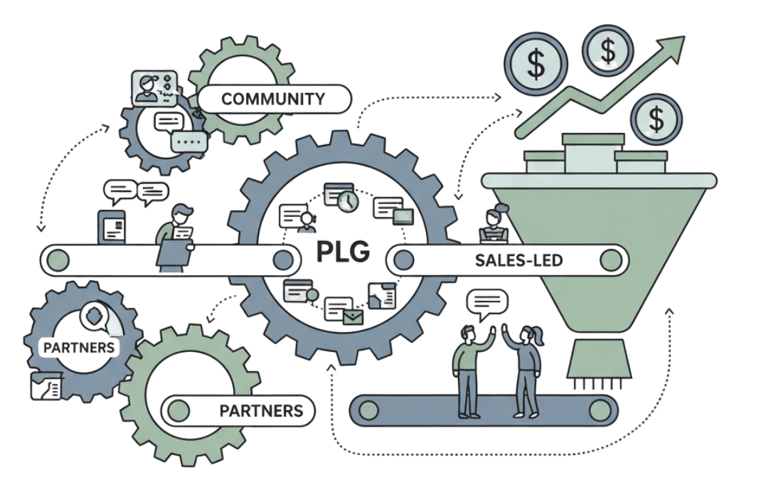How to Choose the Right GTM Motion for Your SaaS Stage
AIGROWTH
11/4/20258 min read

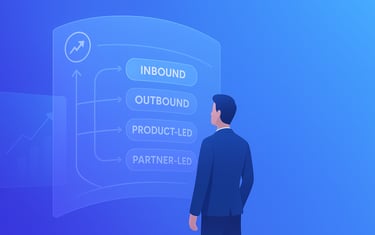
Your product works. Your team is good. But you're not growing.
Why? You're using the wrong playbook for your stage.
At BriskFab, we've helped dozens of SaaS companies grow from $0 to scale. We've seen this pattern: your go-to-market strategy must change as you grow, or you'll stop growing.
Most founders make these mistakes:
They keep doing manual sales when they should automate
They try to build a sales team too early
They copy what Slack did, even though their customers are completely different
This guide shows you exactly which GTM motion to use right now.
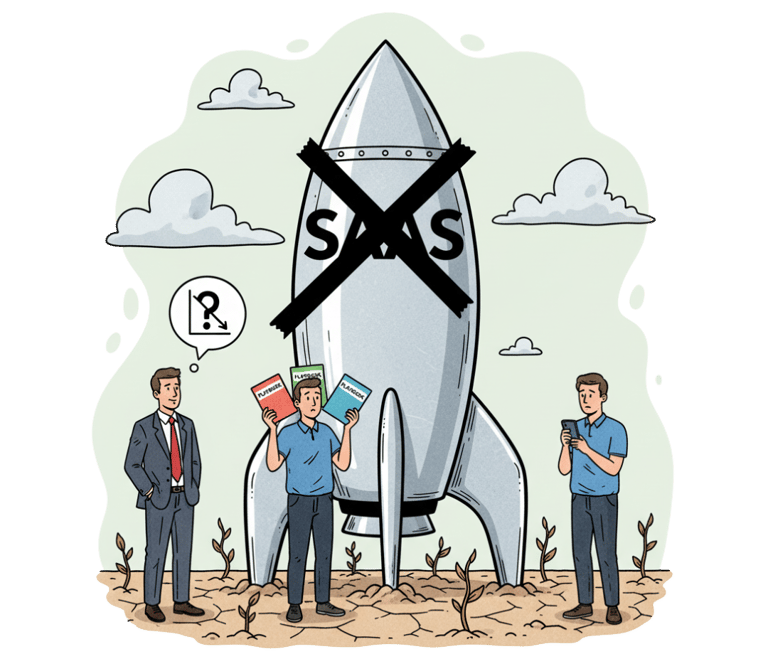

What is a GTM Motion?
A GTM motion is how customers find you, try your product, buy it, and spend more over time.
There are three main types:
1. Product-Led Growth (PLG): People use your product for free first, then pay later. Examples: Figma, Calendly, Notion.
2. Sales-Led Growth: Your sales team talks to customers and closes deals. Examples: Salesforce, Gong.
3. Hybrid (Product-Led + Sales-Assisted): Product gets users started, sales helps them scale. Examples: Slack, Dropbox.
You also have channels that distribute your motion:
Inbound: Content, SEO, and brand marketing.
Outbound: Cold outreach, sales calls, and ABM.
Partner: Ecosystems and resellers that expand your reach.
At BriskFab, we help you pick the right model first, then add channels that actually work.
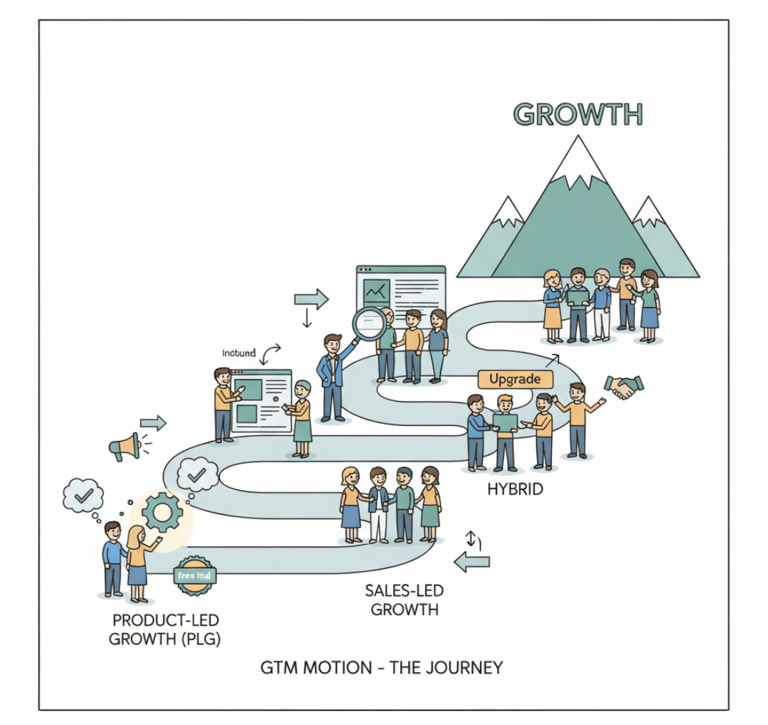

3 Questions to Find Your Best GTM Motion
Question 1: How discoverable is your product?
Can customers experience your product’s value without human help?
If yes: You’re ready for a Product-Led or Inbound-Led motion.
If no: You’ll likely need Outbound or Partner-Led support.
Examples:
Loom works for PLG (anyone can record a video in 30 seconds)
Enterprise security software doesn't (too complex to set up alone)

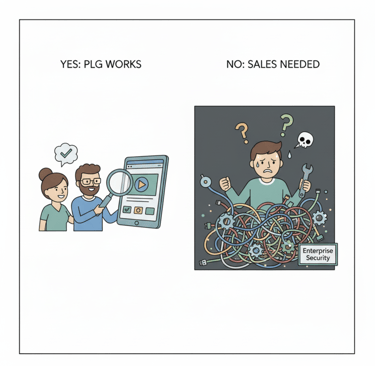
Question 2: What’s your average contract value (ACV)?
This number decides what you can afford to spend to get customers:
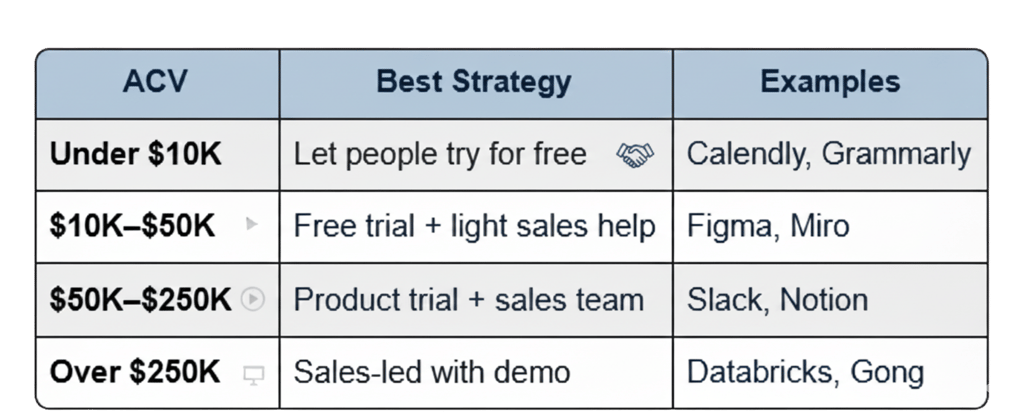

Common myth: PLG only works for low-ticket products. Wrong. Figma closed $50K+ deals with PLG before hiring salespeople.
Question 3: Who uses your product vs. who pays for it?
If the user pays → PLG works great (like developers buying GitHub)
If someone else pays → You need a sales team (like engineers using Datadog, but their VP buys it)
This one question tells you if you can let people sign up themselves or if you need salespeople.

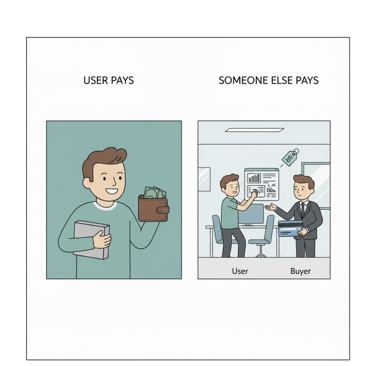
What to Do at Each Growth Stage
Stage 1: $0 to $1M Revenue
Your only goal: Make sure people will actually use your product.
Best Motion: Product-Led or Founder-Led Outbound.
What to do:
Talk to your first initial customers yourself
Watch how they use your product
Fix what confuses them
Numbers to track:
Do 25%+ of signups actually use your product?
Do 40%+ come back after one week?
Can they get value in less than 1 day?
Real story: Loom watched 100+ videos of people using their tool. They saw people couldn't find the Chrome extension. One small fix increased usage by 30%.
Don't do this: Run ads before 25% of signups actually use your product. You're wasting money showing people something broken.
How BriskFab helps: We set up tracking systems and help you interview users before you spend money on ads.
Move to Stage 2 when:
25%+ of signups use your product
People sign up every week without you asking
People tell their friends about it

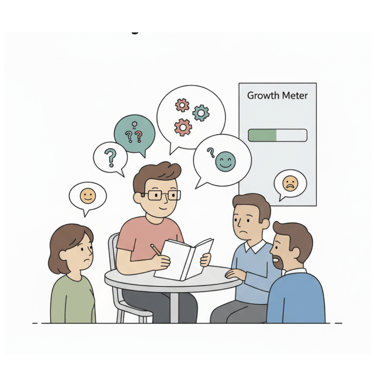
Stage 2: $1M to $5M Revenue
Your goal: Make customer acquisition predictable and repeatable.
Best Motion: Inbound or Hybrid (PLG + Sales-assisted).
If you're doing PLG:
Add features that make people share (like Calendly's "Schedule with me" footer)
Run ads to your free trial (Grammarly does this—15% of free users pay within 3 months)
Write blog posts where people can try your product while reading
If you're doing sales:
Write blog posts about problems your customers search for
Start cold outreach to 2-3 specific types of companies
Keep your sales team small (under 5 people)
Numbers to track:
15-25% of signups should be "ready to buy"
8-15% of those should become paying customers
Get your money back in under 12 months
Real story: HubSpot wrote 2-3 blog posts every day from 2007-2011. They got 1 million visitors per month. That took them to $100M revenue.
Don't do this: Hire a VP of Sales too early. Wait until you've closed 20+ deals yourself with the same pitch.
How BriskFab helps: We build content strategies that get people to sign up (not just read) and show you which users are ready to buy.
Move to Stage 3 when:
You get your money back in under 12 months
You can describe your perfect customer in 3 sentences
Your conversion rates are consistent month to month
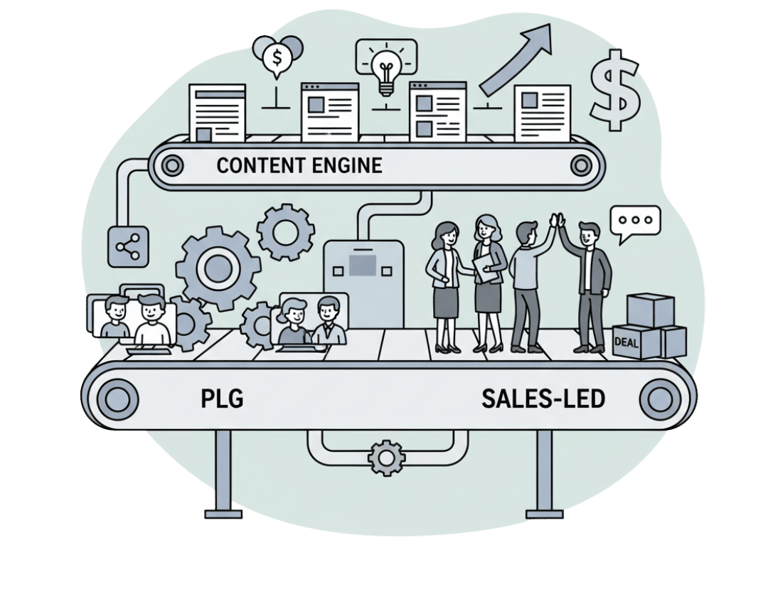

Stage 3: $5M to $20M Revenue
Your goal: Add a second way to get customers before your first way stops working.
Best Motion: Multi-motion model (Outbound + Partner + Community).
What happens: Companies that grow to $10M with just blog traffic see this pattern:
After 18-24 months, growth slows by 20-30%
It costs 40-60% more to get each customer
The solution: Add Product-Led Sales (PLS)
What is PLS: Your product tells your sales team when users are ready to buy.
How it works:
Track signs that users want to upgrade (they invite 5+ teammates, use your product daily)
Sales gets an alert (using AI tools)
Sales calls them: "Saw your team loves Figma — want to talk about our Team plan?"
Real story: Slack did this from 2015-2019. When free teams sent 2,000 messages, sales would call. This grew Slack from $30M to $400M.
Why it works: These warm calls convert 3-5x better than cold calls
Cold calls close 8-12% of the time
Warm calls close 25-40% of the time
Numbers to track:
What % of revenue comes from each method?
How much does each method cost?
How long does it take to close deals?
How BriskFab helps: We build PLS systems that tell your sales team exactly when to call and what to say.
Move to Stage 4 when:
You have 2+ methods each bringing 20%+ of revenue
Customers spend 110%+ more each year
Your best channel is slowing down
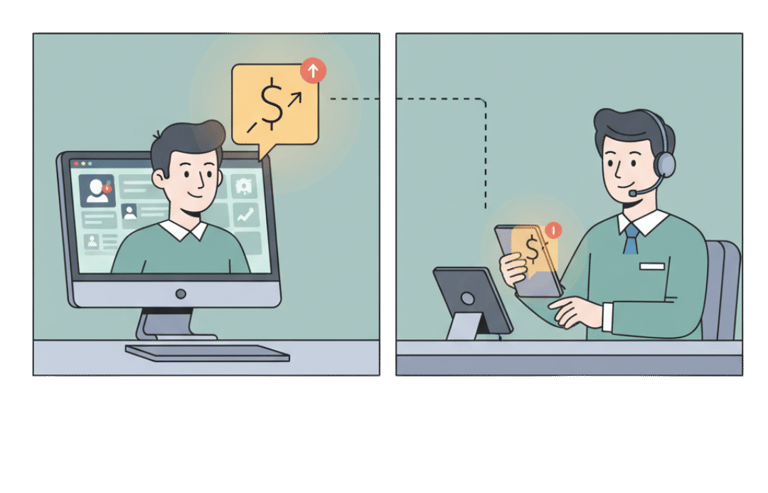

Stage 4: $10M+ Revenue — Build Your Growth Machine
Your goal: Make all your methods work together like a machine.
Best Motion: Orchestrated model across Product, Sales, Partner, and Community.
What this looks like:
Free users share your product
Blog posts bring more signups
Product data tells sales who to call
Sales wins big deals (which become case studies)
Partners bring you into new companies
Happy customers tell others (lower costs)
Real story: Notion (2020-2024)
Free tier + people sharing templates on Twitter
Power users made tutorial videos (for free)
Blog posts ranked on Google
When teams hit 10 people, sales offered paid plans
Built integrations with other tools
Result: Grew from $10M to $2B value with under 50 employees.
Numbers to track:
Do customers spend 120%+ more each year?
What % of revenue comes from partners?
Which combinations of methods work best?
When to hire enterprise sales: After you have 50+ customers paying $50K+/year through PLG alone. Figma did this at $50M revenue.
At BriskFab, we map your growth machine, show you what's working, and fix what's not connected.
When to Add Your Next Method
Don't add too soon. Add when your current method shows these signs:
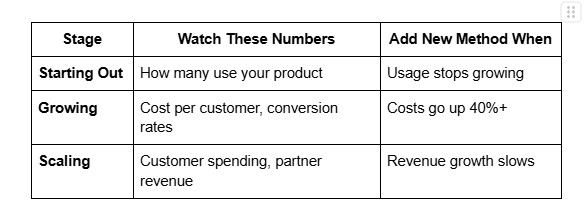

Key rule: Fix your current method before adding a new one. Don't add methods just because competitors are doing it.
What's Next for GTM: AI-Powered Systems
The future isn't about more methods – it's about connecting them smartly.
New AI tools are changing the game:
1. Smarter user scoring: Tools like Pocus use AI to predict which users will upgrade (40-60% more accurate than manual scoring)
2. Personalized outreach at scale: Tools like Clay and Apollo write custom emails for each person based on their company, job, and behavior
3. Automatic sales triggers: Your CRM can now auto-notify sales when users take important actions
Real example: One company found that users who renamed a template in Week 1 were 3x more likely to pay. No human would've noticed that pattern.
At BriskFab, we help you set up these AI-powered systems so your product, marketing, and sales work as one team.
Simple Framework: Three Horizons
Think about your GTM in three layers:
Horizon 1 (80% of revenue): Your main method—optimize it constantly
Horizon 2 (15% today, 40% in 18 months): Your next method – invest here
Horizon 3 (5% today): Your test method – experiment here
Example: Figma 2016-2022
2016-2018:
Main: PLG (free product, viral sharing)
Next: Community (design teachers making tutorials)
Test: Partnerships (plugin ecosystem)
2019-2020:
Main: PLG (still 70% of revenue)
Next: Enterprise sales (growing to 25%)
Test: Agency partnerships
2021-2022:
Main: PLG + Enterprise (balanced)
Next: Partner-led (agencies recommending Figma)
Test: FigJam (new product)
The lesson: They didn't abandon PLG. They added new methods as they grew.
Your Next Step
If you're under $1M: Stop reading. Go talk to 10 users this week. Your job is learning, not growing yet.
If you're $1M-$5M: Check your numbers. If under 25% of signups use your product OR it takes over 12 months to get your money back, fix that first.
If you're $5M-$20M: Look at where your revenue comes from. If one method is over 70%, you're at risk. Start testing method #2 now.
If you're over $20M: Draw how your methods connect. If you can't draw clear lines between them, they're competing instead of helping each other
Get Expert Help with Your GTM Strategy
At BriskFab, we've helped dozens of SaaS companies choose and execute the right GTM motion for their stage.
We help you:
Pick the right GTM model (not copy what others do)
Build systems that show which users are ready to buy
Create content that gets signups (not just traffic)
Add new methods at the right time (before your current one stops working)
👉 Book a free GTM strategy call with our team.
We'll look at your numbers and show you exactly what to do next.
FAQ's
1. What is a GTM motion?
It's how your business gets, keeps, and grows customers. It includes how people find you, try your product, buy it, and spend more over time.
2. How do I pick the right GTM motion?
Answer these: (1) Can people use your product without help? (2) How much do customers pay per year? (3) Is the user also the buyer? Your answers tell you which motion to use.
3. What's the best GTM for early-stage startups?
If you're under $1M revenue, use Product-Led Growth (free trial) or Founder-Led Sales (you sell directly). Your goal is learning what works, not growing fast yet.
4. When should I add partners or community?
When your main method slows down – like when costs go up 40%+ or growth drops for 2 quarters. Usually between $5M-$20M revenue.
5. Why does price affect GTM strategy?
Your price decides what you can afford to spend getting customers. If customers pay $3K/year, you can't spend $15K on sales to get them. The math has to work.
6. What's the future of GTM?
AI-powered systems where your product, marketing, and sales share data and work as one team. Instead of separate methods, everything connects and improves automatically.
The biggest GTM mistake? Waiting until growth stops to change your strategy.
The best companies add method #2 when method #1 still works – before the slowdown hits.
Don't wait. Get ahead.
Talk to BriskFab today and we'll show you your next move.
